Are you a Quiet Speculation member?
If not, now is a perfect time to join up! Our powerful tools, breaking-news analysis, and exclusive Discord channel will make sure you stay up to date and ahead of the curve.
As a new sets come out, the entire Magic writing world speculates on the spoilers. Why wouldn't we? There's not always much else going on during spoiler season, and brewing with new cards and ideas is a significant part of the game's appeal. Plus, if Wizards is going to hand us easy content, it would be rude not to jump at the opportunity. That said, writers don't often look back on their speculations after the set has fully incorporated into their meta. Today, I'm going to revisit my Theros: Beyond Death preview articles, checking on what I got right, where I over- or under-estimated cards, and a notable oversight.
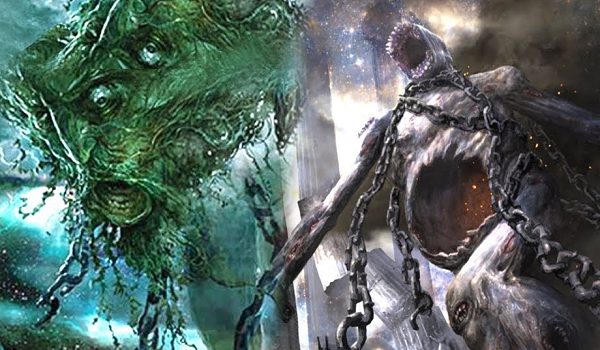
Made It After All
Theros: Beyond Death has been legal for a little over a month. This is enough time for most of the plausible new cards to have been tested, and they should have at least been putting up results. In my two preview articles, I identified eight cards that seemed like reasonable Modern cards. Five have found homes, one is fringe, and the other two haven't got there yet. The five that have made it did so by warping decks around themselves rather than just slotting in.
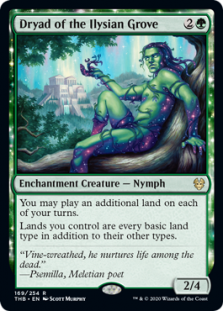 Dryad of the Ilysian Grove
Dryad of the Ilysian Grove
I've already (fairly extensively) covered Dryad of the Ilysian Grove, so I'm not going into much detail today. I predicted that Dryad would find a home in Valakut decks, though it would be a little awkward. Dryad has actually worked out in an unexpected way. I never expected those Valakut decks to be re-built versions of Amulet Titan. I'm forgiving my oversight with the very plausible excuse that Lands Toolbox had never really been a Modern deck before. It's possible to predict which cards will see play, but I never know how deep players will actually go. And Titan players went very deep on Dryad.
Thassa's Oracle
As for Oracle's utility, I hit the nail on the head. It's a combo win condition, and it is being adopted by the very deck I thought it would, Ad Nauseam. What I didn't appreciate was how good it actually was. I definitely never expected Thassa's Oracle to be a four-of in Ad Nauseam. In retrospect, it seems obvious, since it provides another avenue to combo. With a 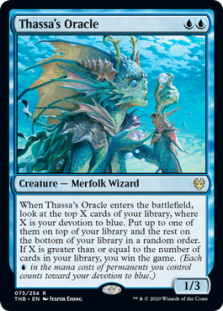 resolved Angel's Grace or Phyrexian Unlife, Ad Naus can cast Spoils of the Vault for a card not in their deck, then cast Oracle for the win. This was never possible with Laboratory Maniac. Part of this was due to costing more up front, but it was mostly because Maniac could be killed in response to the victorious card draw; if Oracle resolves, it wins on the spot.
resolved Angel's Grace or Phyrexian Unlife, Ad Naus can cast Spoils of the Vault for a card not in their deck, then cast Oracle for the win. This was never possible with Laboratory Maniac. Part of this was due to costing more up front, but it was mostly because Maniac could be killed in response to the victorious card draw; if Oracle resolves, it wins on the spot.
The other thing I missed was Oracle's wider appeal. Oracle is seeing play in far more decks than I anticipated. Some of this interest is spillover from Pioneer, where the combo with Inverter of Truth is incredibly powerful (even crossing over into Modern). However, I think it fair to say I underestimated Oracle. The question remains if Oracle will usher in a new combo era, or remain a minor role player. So far, the evidence is lacking, but Oracle's future may be heavily linked to the next card.
Underworld Breach
Underworld Breach is another obvious combo card, and it even had a very obvious home waiting. Then Mox Opal was banned, and said combo never came to be. As I predicted, this 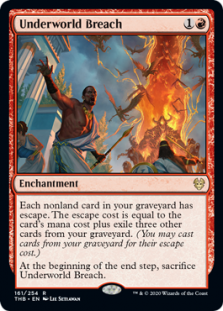 left Breach out in the cold (in Modern, anyway) because it doesn't fit into Storm or other combo decks better than existing options. To be better than Past in Flames, Breach necessitated a very specific deck composition, and it looked like that wasn't possible anymore.
left Breach out in the cold (in Modern, anyway) because it doesn't fit into Storm or other combo decks better than existing options. To be better than Past in Flames, Breach necessitated a very specific deck composition, and it looked like that wasn't possible anymore.
So I was very surprised last week when that the supposedly dead Breach/Grinding Station combo showed up to SCG Indy, followed by Pascal Maynard hyping a very similar deck on twitter. The combo is functionally the same as the banned version would have been, even using the expected win condition of Thassa's Oracle. It isn't as fast without Opal, but the combo is consistent enough that some players are acting like it's the return of Krark-Clan Ironworks. I wouldn't go that far, but given that Breach is seeing the play I expected in the way I anticipated, I'd say I got it right.
Heliod, Sun-Crowned
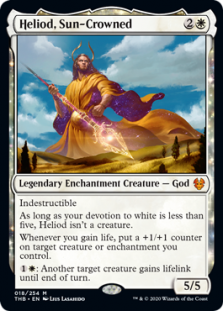 I knew that Heliod, Sun-Crowned would see play. It's a combo piece that can be found with Collected Company; why wouldn't that creature combo pile run it? Heliod joins Walking Ballista as an on-plan win condition. Company can even add in Spike Feeder in place of a Kitchen Finks for another combo. It's Company; the more combos, the merrier.
I knew that Heliod, Sun-Crowned would see play. It's a combo piece that can be found with Collected Company; why wouldn't that creature combo pile run it? Heliod joins Walking Ballista as an on-plan win condition. Company can even add in Spike Feeder in place of a Kitchen Finks for another combo. It's Company; the more combos, the merrier.
However, I thought that Heliod would be a one-of supplementary combo to the main Devoted Druid plan. I definitely didn't see him as a four-of, nor to be seeing widespread success. But the Company decks are completely rebuilding themselves around Heliod, even de-prioritizing Druid combo. Heliod does boast more applications in fair matchups, as lifelinking beaters is a great way to win a race.
Ox of Agonas
Similarly, Ox of Agonas is seeing the play I thought it would, but in far greater quantity. My analysis was that Ox was a payoff card masquerading as Cathartic Reunion. The 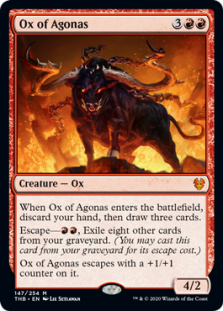 set up required to escape Ox meant that it would only ever be a midgame card. Thus, it could only help Dredge once the engine would either be established or the game was already lost, making it redundant there.
set up required to escape Ox meant that it would only ever be a midgame card. Thus, it could only help Dredge once the engine would either be established or the game was already lost, making it redundant there.
However, Dredge players have all but universally adopted the Ox. I have seen older lists occasionally, but for the most part all Dredge decks are running Ox. However, Ox is at most a two-of. This indicates that while Ox is actually worthwhile, it is mostly so as a payoff card. According to testimony from a local Dredge player, Ox is the best way to restart a stalled engine, especially with an empty hand. It's quite easy for Dredge to struggle to cast topdecked Cathartic Reunion, where Ox doesn't require discarded cards to cast. Also, just being a big red threat that can be cast is huge.
The Wannabes
Next up are those cards that I speculated could be played if things came together for them. They had power and utility if it proved worthwhile, but I was skeptical that the stars would align. One card is slotting into a fringe deck, one has turned out to not work in Modern, and the last is a victim of its archetype.
The Other Gods
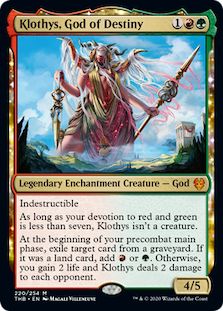 Klothys, God of Destiny got a look because graveyard hate is good in Modern, and hard-to-kill clocks are great against slower decks. I thought that it would be a decent card against Jund in decks that need sticky threats, and that the triggered ability would be the only draw.
Klothys, God of Destiny got a look because graveyard hate is good in Modern, and hard-to-kill clocks are great against slower decks. I thought that it would be a decent card against Jund in decks that need sticky threats, and that the triggered ability would be the only draw.
It turns out that a lot of Klothys' utility so far has been attacking. She's not seeing play in Jund, nor as a sideboard card. Instead, she's been a two-of in Utopia Sprawl decks. There, Klothys is intended to be a creature most of the time. She's not the most impressive threat, but continuously attacking graveyards while threatening a big, devotion-fueled swing isn't terrible.
Meanwhile, Purphoros, Bronze-Blooded is going nowhere. Purphoros is too inefficient compared to Through the Breach to be worthwhile, even if he could sneak in Emrakul. Through the Breach isn't really doing much in the first place, so why would a more mana-intensive version be better? Repeatability is rarely a draw in the kind of deck that runs Breach.
Setessan Champion
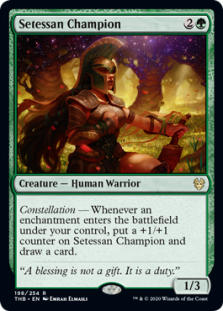 I thought that Setessan Champion would shake up Bogles by challenging Kor Spiritdancer. That hasn't happened. This is not for a lack of power, because I'm not the only one who thinks Setessan Champion is Modern playable; it has caught on in Legacy Enchantress. What I failed to account for is that Bogles is a very metagame-specific deck, and we are not seeing the type of metagame where Bogles can survive. I don't know of anyone trying to make Bogles work, and the most recent result for Bogles comes from January. The door is closed for Bogles right now, let alone for innovation or tweaking within that shell.
I thought that Setessan Champion would shake up Bogles by challenging Kor Spiritdancer. That hasn't happened. This is not for a lack of power, because I'm not the only one who thinks Setessan Champion is Modern playable; it has caught on in Legacy Enchantress. What I failed to account for is that Bogles is a very metagame-specific deck, and we are not seeing the type of metagame where Bogles can survive. I don't know of anyone trying to make Bogles work, and the most recent result for Bogles comes from January. The door is closed for Bogles right now, let alone for innovation or tweaking within that shell.
A Titanic Miss
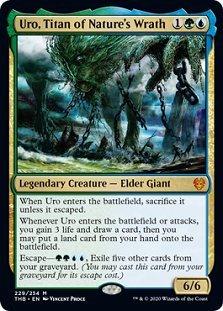 The gaping hole in my predictions was the Titans: Kroxa, Titan of Death's Hunger and Uro, Titan of Nature's Wrath. I didn't mention them at all in my preview articles, because I had dismissed them outright. The discussion at the time surrounding the two cards centered on using Hushbringer to get around the drawback. The whole plan was to get a 6/6 in play for cheap and start attacking, a gameplan unworthy of Modern. As a sideboard bonus in particular matchups it's fine, but if playing under-costed fatties with no ETB trigger was good enough, Mono-Green Stompy would be competitive. Then there was the issue of graveyard hate defeating both cards. They just didn't look good enough.
The gaping hole in my predictions was the Titans: Kroxa, Titan of Death's Hunger and Uro, Titan of Nature's Wrath. I didn't mention them at all in my preview articles, because I had dismissed them outright. The discussion at the time surrounding the two cards centered on using Hushbringer to get around the drawback. The whole plan was to get a 6/6 in play for cheap and start attacking, a gameplan unworthy of Modern. As a sideboard bonus in particular matchups it's fine, but if playing under-costed fatties with no ETB trigger was good enough, Mono-Green Stompy would be competitive. Then there was the issue of graveyard hate defeating both cards. They just didn't look good enough.
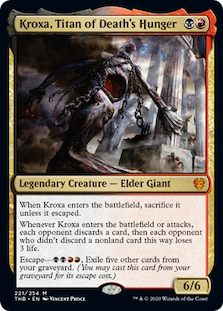 In fact, they are more than good enough. Reid Duke declared that Kroxa belonged in Jund, and then Jund won SCG Indianapolis' Modern Classic with Kroxa: as the Jundfather speaks, so it shall be. Meanwhile, every UGx deck appears to be forcing Uro like it's Oko, Thief of Crowns. Players like value, and tapping the graveyard as a resource has impressive precedent in Modern. Uro and Kroxa combine both, and trigger on attacks, evoking Primeval Titan. Snowballing value while attacking with a 6/6 is a great way to win a game, and that appears to be exactly what both Titans are doing.
In fact, they are more than good enough. Reid Duke declared that Kroxa belonged in Jund, and then Jund won SCG Indianapolis' Modern Classic with Kroxa: as the Jundfather speaks, so it shall be. Meanwhile, every UGx deck appears to be forcing Uro like it's Oko, Thief of Crowns. Players like value, and tapping the graveyard as a resource has impressive precedent in Modern. Uro and Kroxa combine both, and trigger on attacks, evoking Primeval Titan. Snowballing value while attacking with a 6/6 is a great way to win a game, and that appears to be exactly what both Titans are doing.
However...
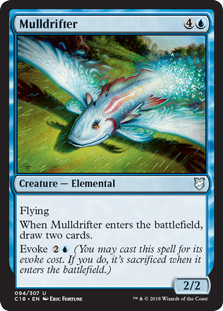 All that being said, I still don't think either Titan is as good as their hype suggests. The fundamental problem with Uro and Kroxa is that for them to actually be creatures, they have to escape. There's no work-around. Evoke is clearly the genesis of the Titans, and they're meant to work in a similar fashion. However, Form of the Mulldrifter can be rescued from being sacrificed with flicker effects; flickering a Titan kills it. Spell Queller an evoked creature, and the creature lives if recast. Quell an escaped Uro, and it dies with the Spirit.
All that being said, I still don't think either Titan is as good as their hype suggests. The fundamental problem with Uro and Kroxa is that for them to actually be creatures, they have to escape. There's no work-around. Evoke is clearly the genesis of the Titans, and they're meant to work in a similar fashion. However, Form of the Mulldrifter can be rescued from being sacrificed with flicker effects; flickering a Titan kills it. Spell Queller an evoked creature, and the creature lives if recast. Quell an escaped Uro, and it dies with the Spirit.
I also have to bang the drum of graveyard hate completely nerfing both Titans. Against Rest in Peace, Uro and Kroxa are more expensive Growth Spiral and Raven's Crime, respectively. Even Scavenging Ooze wrecks their value. Going through decklists, particularly the Uro lists, indicates that these are decks that should have graveyard hate brought in anyway.
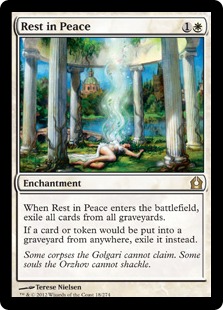 Finally, I suspect that a lot of value for both cards comes from players not understanding how they work. I had a Legacy player gush to me about Uro winning him an otherwise lost match thanks to multiple escapes. Upon further questioning, it came out that the opponent had been destroying Uro with Pyroblast. They'd forgotten or simply didn't know that escaping Uro isn't like unearthing Hellspark Elemental. The former casts the card while the latter puts in directly into play. Had the opponent understood that and countered Uro rather than destroying it, they might have won the game rather than being grinded out.
Finally, I suspect that a lot of value for both cards comes from players not understanding how they work. I had a Legacy player gush to me about Uro winning him an otherwise lost match thanks to multiple escapes. Upon further questioning, it came out that the opponent had been destroying Uro with Pyroblast. They'd forgotten or simply didn't know that escaping Uro isn't like unearthing Hellspark Elemental. The former casts the card while the latter puts in directly into play. Had the opponent understood that and countered Uro rather than destroying it, they might have won the game rather than being grinded out.
Case In Point
Last week at a weekly Modern event at my LGS, Mythic Games, there were several UGx Uro decks. The Temur Uro deck and Sultai Uro deck hit each other Round 2 and went to time, with the Temur deck winning. At various points in every game, one deck would be poised to win before the other started escaping Uro to gradually grind their way back in. The life cushion was  very valuable, but more importantly, a 6/6 traded with everything on either side of the board. The final game came down to the Temur deck having slightly more threats than the Sultai deck. As far as I could tell, neither deck ran any graveyard hate.
very valuable, but more importantly, a 6/6 traded with everything on either side of the board. The final game came down to the Temur deck having slightly more threats than the Sultai deck. As far as I could tell, neither deck ran any graveyard hate.
This was relevant because neither deck won when graveyard hate was cast. While Temur won our event, it did so because the Jund deck it faced the next round misplayed into terrible draws to lose Game 3. In Game 2, Temur lost hard to Inquisition of Kozilek into turn three Scavenging Ooze to eat Uro. With the only way to break parity with Jund eliminated, Temur stood no chance. I hit the Sultai deck round four, playing Humans, and I won Game 3 thanks to Grafdigger's Cage nuking both Uro and Snapcaster Mage. I'd lost Game 1 to a wall of removal, and Game 2 I Reflector Maged my way through multiple Uros. When the Titans get rolling, they're avalanches. But getting them going is surprisingly hard, and nigh impossible through the right kind of hate.
You Never Know
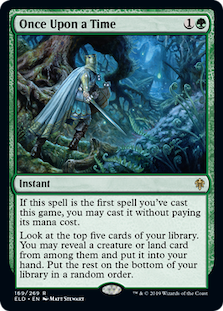 Overall, the only card that I'd say I got exactly right was Underworld Breach; I was in the ballpark for the rest. As for the Titans, there are so many asterisks over their future that I'm still skeptical they'll stick around in Modern. But hey, I was wrong the first time!
Overall, the only card that I'd say I got exactly right was Underworld Breach; I was in the ballpark for the rest. As for the Titans, there are so many asterisks over their future that I'm still skeptical they'll stick around in Modern. But hey, I was wrong the first time!
Wizards has announced that there will be a Banned and Restricted Announcement next Monday. All the schtick about announcing an announcement aside, it is nice to receive a head's-up. I'd be very surprised if anything happened in Modern given the huge shakeup a few months ago, but anything is possible. If something were to go, I suspect it would be the ubiquitous Once Upon a Time, given its present share of 33% across all decks according to MTGGoldfish. Again, I think it's too soon, but we'll all find out next week.




I think the titans are here to stay in Jund and Bant snow decks, but I, like you, don’t foresee a them being widely adopted.
I’m desperately looking forward to the B&R announcement, as I fully expect some action on Once Upon a Time.
You mentioned that you were able to use Reflector Mage to keep an Auto at bay, are you still on U/W Spirits these days or have you moved on to Humans? How do you do you like fair creature based strategies like Fish, Spirits, and Humans in the current meta?
And as always, thanks for the insights.
At the point that we’re seeing otherwise colorless Eldarzi Tron splashing Once off a single Forest, it’s time for Once to go.
I’ve been on Humans for a while now since it’s better positioned. Thalia and Meddling Mage are far better positioned than Mausoleum Wanderer and Spell Queller against the combo decks and it’s easier to play Magus of the Moon in Humans than Blood Moon in Spirits. That said, disruptive creature aggro is being underplayed across the board at the moment. The true combo decks are precariously built and relatively easy to disrupt. Meanwhile, Amulet is so dependent on Dryad that bounce effects can be devastating and it doesn’t run much interaction.